Role of Surface Preparation in Corrosion Resistance Due to Silane Coatings on a Magnesium Alloy
Abstract
:1. Introduction
1.1. Corrosion of Magnesium Alloys
1.2. Organo-Silane Coatings for Improvement in Corrosion Resistance
2. Materials and Methods
2.1. Test Materials
2.1.1. Alloy Sample Preparation and Surface Treatments
- Substrate ground to 2500 grit finish, degreased with ethanol and dried with compressed air (henceforth, referred as uncoated substrate).
- Immersion of ground substrates (2500 grit finish) in 3 M NaOH for 48 h (with a view to achieving a uniform distribution of hydroxide on the surface).
- Potentiostatic polarization of ground substrate (2500 grit finish) in 3 M NaOH for 600 s at 100 mV (with respect to SCE) to form hydroxide on surface. This potential (100 mVSCE) was selected based on the potentiodynamic polarization of pure magnesium in 3 M NaOH solution [35].
2.1.2. Hydrolysis of Silane
2.1.3. Coating AZ91D with BTSE
2.2. Electrochemical Impedance Spectroscopy of Coatings
3. Results and Discussion
3.1. Surface Morphology of the Coated Alloy
3.2. Electrochemical Impedance Spectroscopy (EIS)
4. Conclusions
Author Contributions
Funding
Institutional Review Board Statement
Informed Consent Statement
Data Availability Statement
Conflicts of Interest
Sample Availability
References
- Avedesian, M.M.; Baker, H. Magnesium and Magnesium Alloys. In ASM Speciality Handbook, 1st ed.; ASM International: Novelty, OH, USA, 1999; pp. 138–162. [Google Scholar]
- Zberg, B.; Uggowitzer, P.J.; Löffler, J.F. MgZnCa glasses without clinically observable hydrogen evolution for biodegradable implants. Nat. Mater. 2009, 8, 887. [Google Scholar]
- Staiger, M.P.; Pietak, A.M.; Huadmai, J.; Dias, G. Magnesium and its alloys as orthopedic biomaterials: A review. Biomaterials 2006, 27, 1728. [Google Scholar] [CrossRef]
- Kannan, M.B.; Raman, R.K.S. In-vitro Degradation and mechanical integrity of Calcium-containing magnesium alloys in modified-simulated body fluid. Biomaterials 2008, 29, 2306–2314. [Google Scholar] [CrossRef]
- Choudhary, L.; Raman, R.K.S. Magnesium alloys as body implants: Fracture mechanism under dynamic and static loadings in a physiological environment. Acta Biomater. 2012, 8, 916–923. [Google Scholar] [CrossRef]
- Sundararajan, G.P.; Ooij, W.J.v. Silane based pretreatments for automotive steels. Surf. Eng. 2000, 16, 315. [Google Scholar] [CrossRef]
- Subramanian, V.; Ooij, W.J.v. Silane Based Metal Pretreatments as Alternatives to Chromating. Surf. Eng. 1999, 15, 168. [Google Scholar] [CrossRef]
- Gray, J.E.; Luan, B. Protective coatings on magnesium and its alloys a critical review. J. Alloy. Compd. 2002, 336, 88. [Google Scholar] [CrossRef]
- Hafeez, M.A.; Farooq, A.; Zang, A.; Saleem, A.; Deen, K.M. Phosphate chemical conversion coatings for magnesium alloys: A review. J. Coat. Technol. Res. 2020, 17, 827–849. [Google Scholar] [CrossRef]
- Saji, V.S. Review of rare-earth-based conversion coatings for magnesium and its alloys. J. Mater. Res. Technol. 2019, 8, 5012–5035. [Google Scholar] [CrossRef]
- Guo, Y.; Su, Y.; Gu, R.; Zhang, Z.; Li, G.; Lian, J.; Ren, L. Enhanced corrosion resistance and biocompatibility of biodegradable magnesium alloy modified by calcium phosphate/collagen coating. Surf. Coat. Technol. 2020, 401, 126318. [Google Scholar] [CrossRef]
- Bakhsheshi-Rad, H.R.; Ismail, A.F.; Aziz, M.; Akbari, M.; Hadisi, Z.; Khoshnava, S.M.; Pagan, E.; Chen, X. Co-incorporation of graphene oxide/silver nanoparticle into poly-L-lactic acid fibrous: A route toward the development of cytocompatible and antibacterial coating layer on magnesium implants. Mater. Sci. Eng. C 2020, 111, 110812. [Google Scholar] [CrossRef]
- Xie, C.; Li, H.; Zhou, X.; Sun, C. Corrosion behavior of cold sprayed pure zinc coating on magnesium. Surf. Coat. Technol. 2019, 374, 797–806. [Google Scholar] [CrossRef]
- Li, L.; Cui, L.; Zeng, R.; Li, S.; Chen, X.; Zheng, Y.; Kannan, M.B. Advances in functionalized polymer coatings on biodegradable magnesium alloys—A review. Acta Biomater. 2018, 79, 23–36. [Google Scholar] [CrossRef] [PubMed]
- Al-Saadi, S.; Raman, R.K.S. Two-Step Silane Coating Containing Quaternary Ammonium Silane for Mitigation of Microbial Corrosion of Mild Steel. ACS Omega 2021, 6. [Google Scholar] [CrossRef]
- Al-Saadi, S.; Raman, R.K.S. A Long Aliphatic Chain Functional Silane for Corrosion and Microbial Corrosion Resistance of Steel. Prog. Org. Coat. 2019, 127, 27–36. [Google Scholar] [CrossRef]
- Al-Saadi, S.; Banerjee, P.C.; Raman, R.K.S. Corrosion of Bare and Silane-Coated Mild Steel in Chloride Medium with and without Sulphate Reducing Bacteria. Prog. Org. Coat. 2017, 111, 231–239. [Google Scholar] [CrossRef]
- Franquet, A.; Terryn, H.; Bertrand, P.; Vereecken, J. Use of optical methods to characterize thin silane films coated on aluminium. Surf. Interface Anal. 2002, 34, 25–29. [Google Scholar] [CrossRef]
- Almanza-Workman, A.M.; Raghavan, S.; Petrovic, S.; Gogoi, B.; Deymier, P.; Monk, D.J.; Roop, R. Characterization of highly hydrophobic coatings deposited onto pre-oxidized silicon from water dispersible organosilanes. Thin Solid Films 2003, 423, 77–87. [Google Scholar] [CrossRef]
- Cabral, A.M.; Duarte, R.G.; Montemor, M.F.; Ferreira, M.G.S. A comparative study on the corrosion resistance of AA2024-T3 substrates pre-treated with different silane solutions: Composition of the films formed. Prog. Org. Coat. 2005, 54, 322–331. [Google Scholar] [CrossRef]
- Hu, J.; Li, Q.; Zhong, X.; Kang, W. Novel anti-corrosion silicon dioxide coating prepared by sol-gel method for AZ91D magnesium alloy. Prog. Org. Coat. 2008, 63, 13–17. [Google Scholar] [CrossRef]
- Hu, J.-M.; Liu, L.; Zhang, J.-Q.; Cao, C.-N. Effects of electrodeposition potential on the corrosion properties of bis-1,2-[triethoxysilyl] ethane films on aluminium alloy. Electrochem. Acta 2006, 51, 3944–3949. [Google Scholar] [CrossRef]
- Kim, J.; Wong, P.C.; Wong, K.C.; Sodhi, R.N.S.; Mitchell, K.A.R. Adsorption of BTSE and [gamma]-GPS organosilanes on different microstructural regions of 7075-T6 aluminum alloy. Appl. Surf. Sci. 2007, 253, 3133–3143. [Google Scholar] [CrossRef]
- Supplit, R.; Koch, T.; Schubert, U. Evaluation of the anti-corrosive effect of acid pickling and sol-gel coating on magnesium AZ31 alloy. Corros. Sci. 2007, 49, 3015–3023. [Google Scholar] [CrossRef]
- Susac, D.; Sun, X.; Mitchell, K.A.R. Adsorption of BTSE and [gamma]-APS organosilanes on different microstructural regions of 2024-T3 aluminum alloy. Appl. Surf. Sci. 2003, 207, 40. [Google Scholar] [CrossRef]
- Zheludkevich, M.L.; Yasakau, K.A.; Poznyak, S.K.; Ferreira, M.G.S. Triazole and thiazole derivatives as corrosion inhibitors for AA2024 aluminium alloy. Corros. Sci. 2005, 47, 3368–3383. [Google Scholar] [CrossRef]
- Franquet, A.; Terryn, H.; Vereecken, J. Study of the effect of different aluminium surface pretreatments on the deposition of thin non-functional silane coatings. Surf. Interface Anal. 2004, 36, 681–684. [Google Scholar] [CrossRef]
- Qiu, Z.-M.; Zeng, R.-C.; Zhang, F.; Song, L.; Li, S.-Q. Corrosion resistance of Mg−Al LDH/Mg(OH)2/silane−Ce hybrid coating on magnesium alloy AZ31. Trans. Nonferrous Met. Soc. China 2020, 30, 2967–2979. [Google Scholar] [CrossRef]
- Najibzad, A.S.; Aminia, R.; Rostami, M.; Kardar, P.; Fedel, M. Active corrosion performance of magnesium by silane coatings reinforced with polyaniline/praseodymium. Prog. Org. Coat. 2020, 10, 105504. [Google Scholar] [CrossRef]
- Zhanga, Z.-Q.; Zenga, R.-C.; Linb, C.-G.; Wang, L.; Chen, X.-B.; Chen, D.-C. Corrosion resistance of self-cleaning silane/polypropylene composite coatings on magnesium alloy AZ31. J. Mater. Sci. Technol. 2020, 41, 43–55. [Google Scholar] [CrossRef]
- Toorani, M.; Aliofkhazraei, M.; Mahdavianb, M.; Naderi, R. Effective PEO/Silane pretreatment of epoxy coating applied on AZ31B Mg alloy for corrosion protection. Corros. Sci. 2020, 169, 108608. [Google Scholar] [CrossRef]
- Xue, K.; Liang, L.-X.; Cheng, S.-C.; Liu, H.-P.; Cui, L.-Y.; Zeng, R.-C.; Li, S.-Q.; Wang, Z.-L. Corrosion resistance, antibacterial activity and drug release of ciprofloxacin-loaded micro-arc oxidation/silane coating on magnesium alloy AZ31. Prog. Org. Coat. 2021, 158, 106357. [Google Scholar] [CrossRef]
- Toorani, M.; Aliofkhazraei, M.; Mahdavian, M.; Naderi, R. Superior corrosion protection and adhesion strength of epoxy coating applied on AZ31 magnesium alloy pre-treated by PEO/Silane with inorganic and organic corrosion inhibitors. Corros. Sci. 2021, 178, 109065. [Google Scholar] [CrossRef]
- Toorani, M.; Aliofkhazraei, M. Review of electrochemical properties of hybrid coating systems on Mg with plasma electrolytic oxidation process as pre-treatment. Surf. Interfaces 2019, 14, 262–295. [Google Scholar] [CrossRef]
- Banerjee, P.C.; Raman, R.K.S.; Durandet, Y.; McAdam, G. Electrochemical Investigation of the Influence of Laser Surface Melting on the Microstructure and Corrosion Behaviour of ZE41 Magnesium Alloy-An EIS Based Study. Corros. Sci. 2011, 53, 1505–1514. [Google Scholar] [CrossRef]
- Lamaka, S.V.; Montemor, M.F.; Galio, A.F.; Zheludkevich, M.L.; Trindade, C.; Dick, L.F.; Ferreira, M.G.S. Novel hybrid sol-gel coatings for corrosion protection of AZ31B magnesium alloy. Electrochim. Acta 2008, 53, 4773–4783. [Google Scholar] [CrossRef]
- Barsoukov, E.; Macdonald, J.R. Impedance Spectroscopy Theory, Experiment, and Applications, 2nd ed.; John Wiley & Sons, Inc.: Hoboken, NJ, USA, 2005; p. 595. [Google Scholar]
- Bonora, P.L.; Deflorian, F.; Fedrizzi, L. Electrochemical impedance spectroscopy as a tool for investigating underpaint corrosion. Electrochim. Acta 1996, 41, 1073–1082. [Google Scholar] [CrossRef]
- Mansfeld, F. Models for the impedance behavior of protective coatings and cases of localized corrosion. Electrochim. Acta 1993, 38, 1891–1897. [Google Scholar] [CrossRef]
- Zhao, M.-C.; Liu, M.; Song, G.-L.; Atrens, A. Influence of pH and chloride ion concentration on the corrosion of Mg alloy ZE41. Corros. Sci. 2008, 50, 3168–3178. [Google Scholar] [CrossRef]
- Zucchi, F.; Grassi, V.; Frignani, A.; Monticelli, C.; Trabanelli, G. Electrochemical behaviour of a magnesium alloy containing rare earth elements. J. Appl. Electrochem. 2006, 36, 195–204. [Google Scholar] [CrossRef]
- Mansfeld, F.; Fernandes, J.C.S. Impedance spectra for aluminum 7075 during the early stages of immersion in sodium chloride. Corros. Sci. 1993, 34, 2105–2108. [Google Scholar] [CrossRef]
- Liu, M.; Zanna, S.; Ardelean, H.; Frateur, I.; Schmutz, P.; Song, G.; Atrens, A.; Marcus, P. A first quantitative XPS study of the surface films formed, by exposure to water, on Mg and on the Mg-Al intermetallics: Al3Mg2 and Mg17Al12. Corros. Sci. 2009, 51, 1115–1127. [Google Scholar] [CrossRef]
- Montemor, M.F.; Ferreira, M.G.S. Analytical and microscopic characterisation of modified bis-[triethoxysilylpropyl] tetrasulphide silane films on magnesium AZ31 substrates. Prog. Org. Coat. 2007, 60, 228–237. [Google Scholar] [CrossRef]
- Montemor, M.F.; Ferreira, M.G.S. Electrochemical study of modified bis-[triethoxysilylpropyl] tetrasulfide silane films applied on the AZ31 Mg alloy. Electrochim. Acta 2007, 52, 7486–7495. [Google Scholar] [CrossRef]
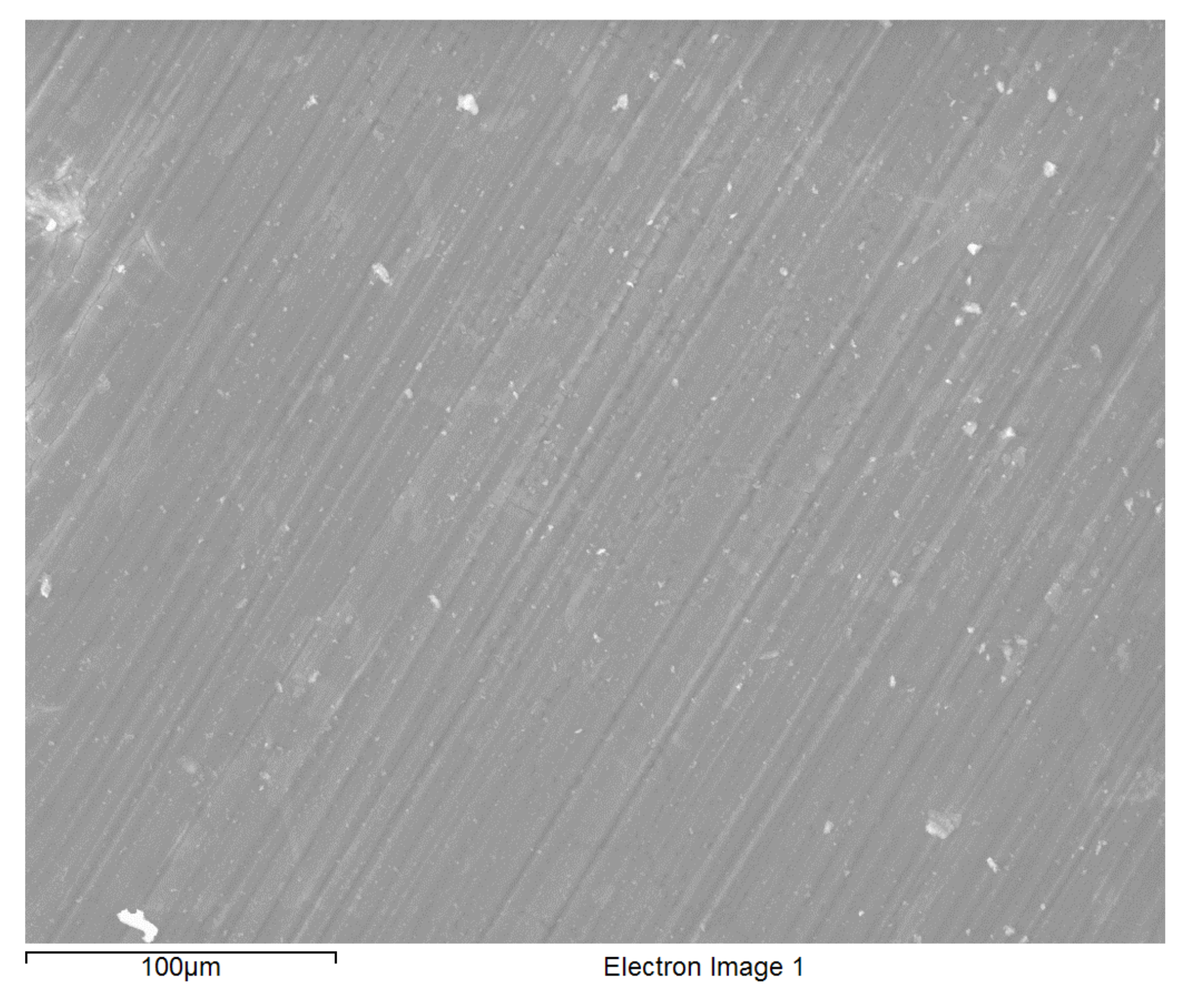
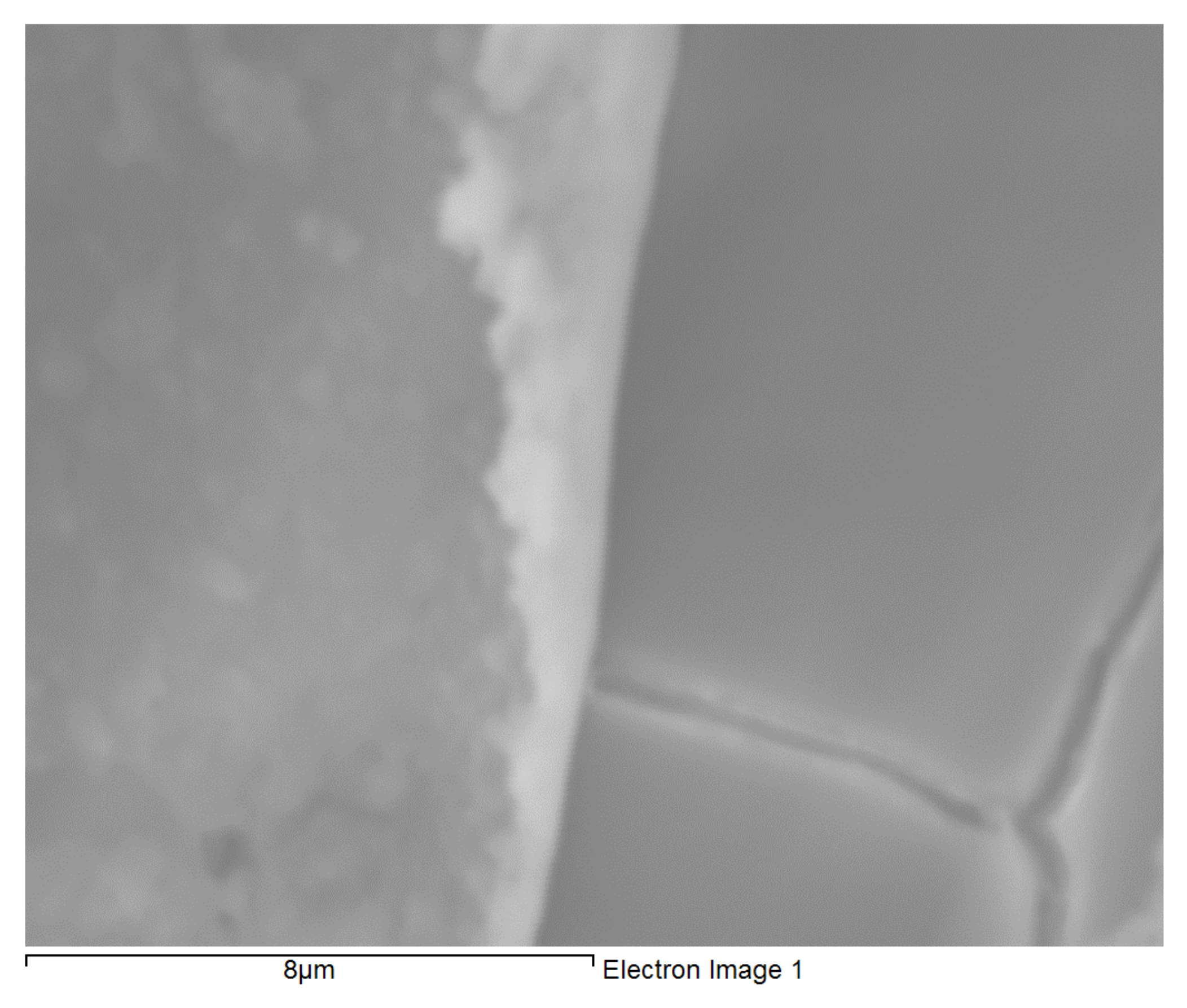

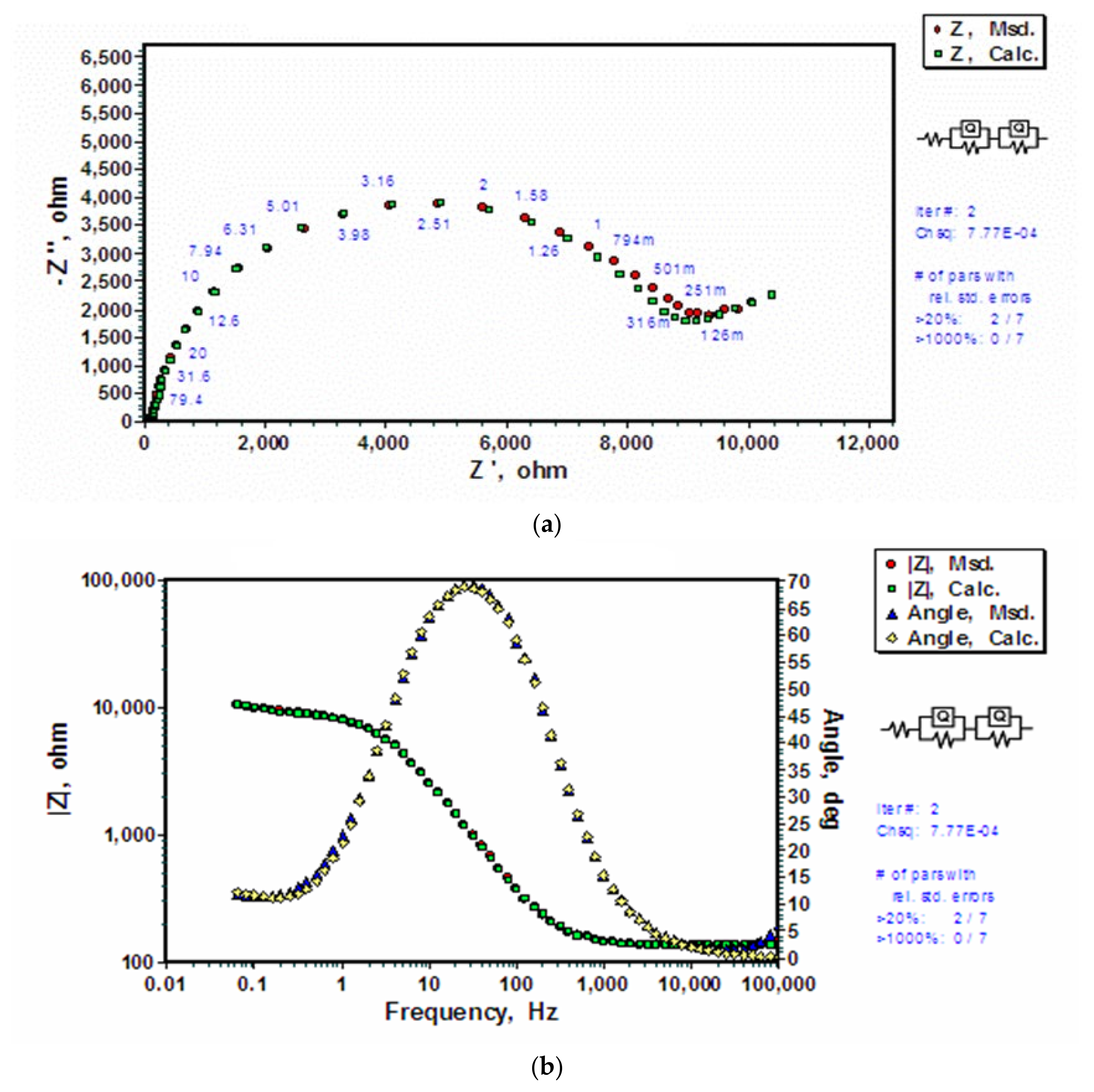
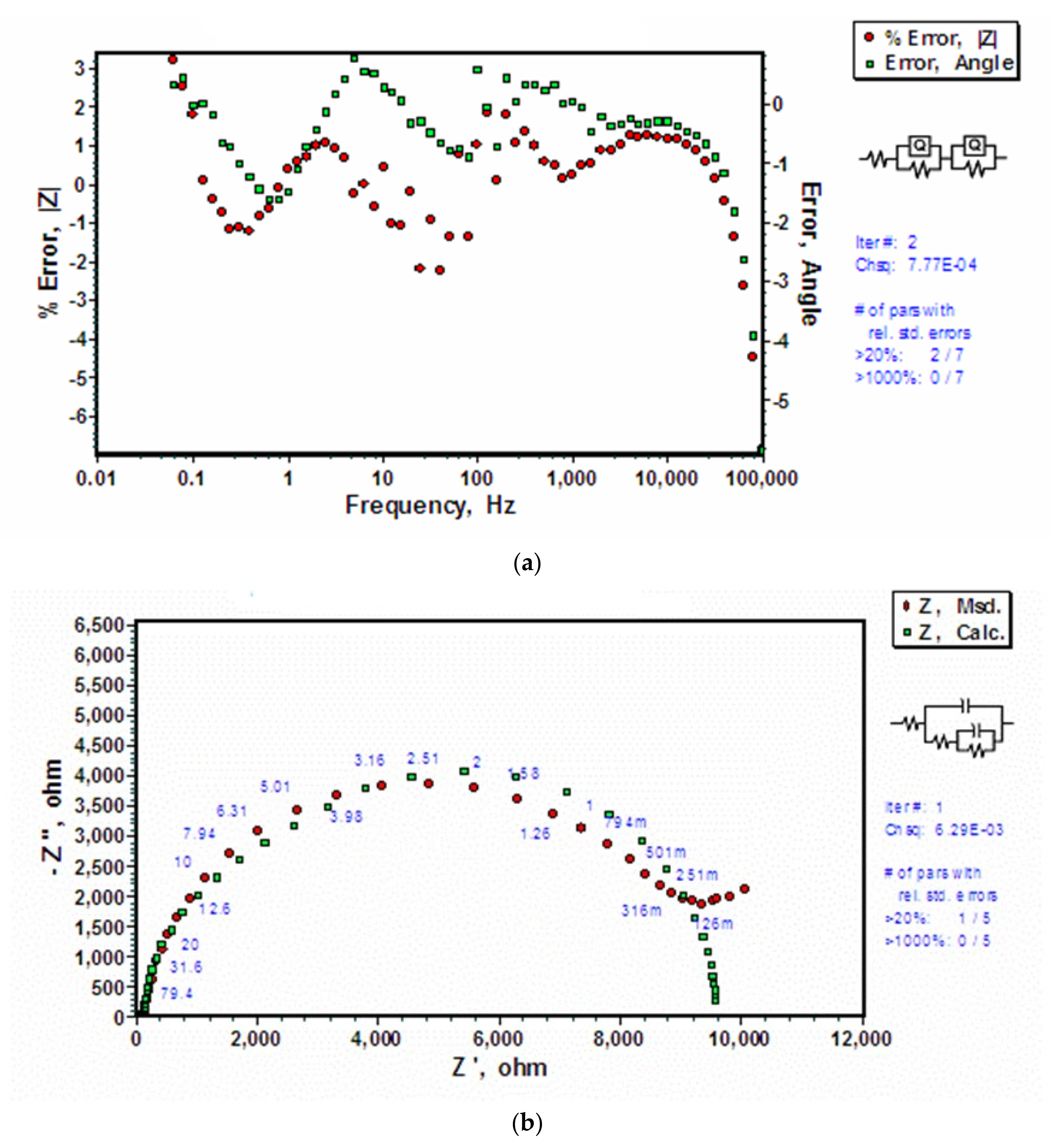

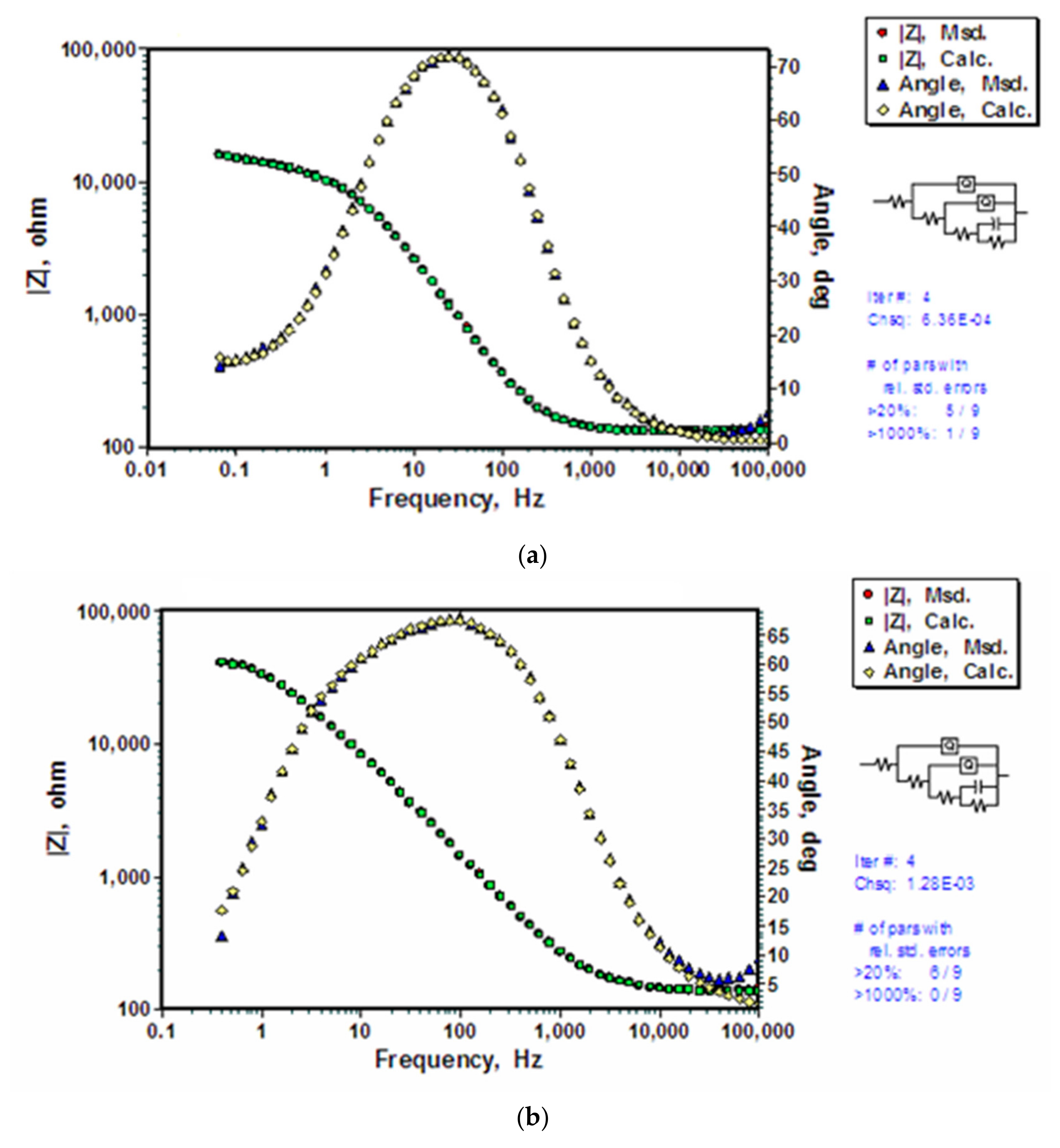
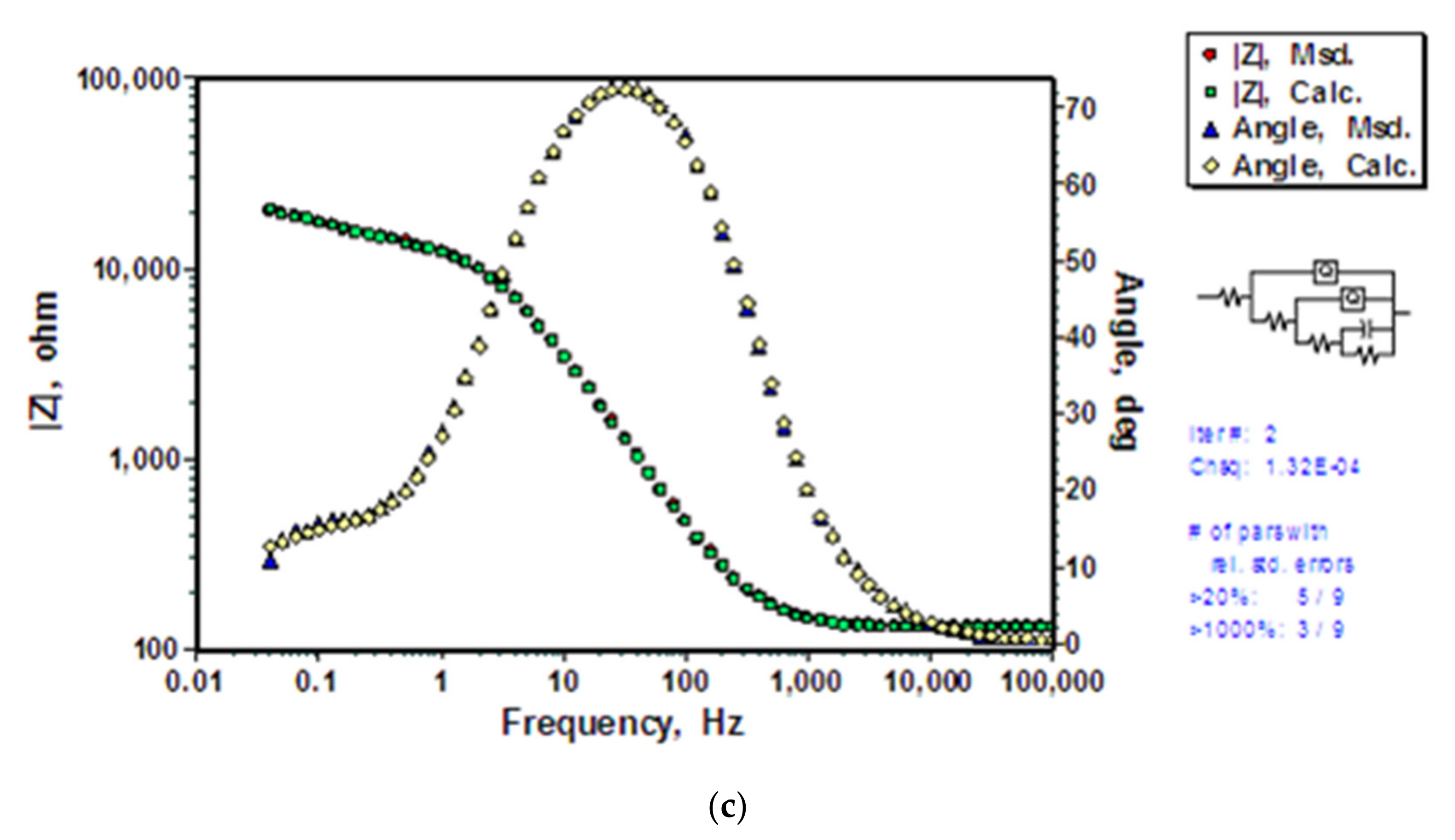
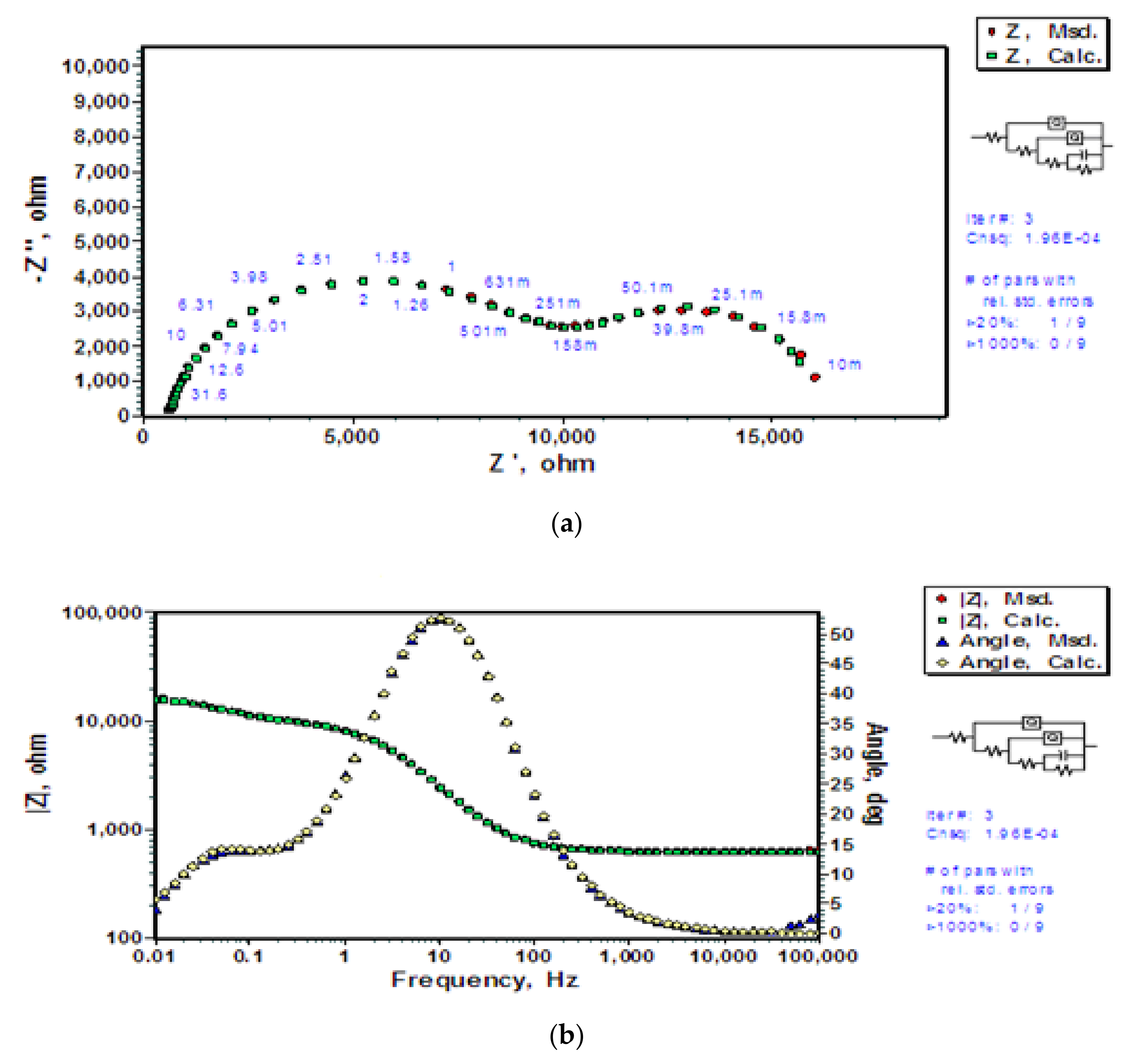
| Parameter | Estimated Value | Standard Error (%) # |
|---|---|---|
| Rs (Ω) | 138.1 | 0.6719 |
| Qo-Yo (F) | 8.19 × 10−6 | 2.543 |
| Qo-n | 0.9226 | 1.145 |
| Ro (Ω) | 8463 | 4.138 |
| Qdl-Yo (F) | 0.000595 | 19.9 |
| Qdl-n | 0.7571 | 20.78 |
| Rdl (Ω) | 7288 | 53.67 |
| Parameter | Untreated Substrate | Substrate Polarized in Hydroxide | Substrate Dipped in Hydroxide | |||
|---|---|---|---|---|---|---|
| Estimated Value | Standard Error (%) | Estimated Value | Standard Error (%) | Estimated Value | Standard Error (%) | |
| Rs (Ω) | 134.7 | 0.74 | 131.6 | 0.41 | 3.32 × 10−4 | 5.82 × 107 |
| CSi (F) | 4.10 × 10−6 | 18.41 | 2.74 × 10−6 | 8.94 | 1.29 × 10−9 | 279.6 |
| RSi (Ω) | 1.37 × 104 | 3.05 | 1.43 × 104 | 1.01 | 9.35 × 103 | 8.36 |
| Qh-Y0 (F) | 7.20 × 106 | 8.05 | 4.54 × 10−6 | 3.69 | 4.99 × 10−6 | 4.40 |
| Qh-n | 0.70 | 10.67 | 0.78 | 3.40 | 0.81 | 0.51 |
| Rh (Ω) | 145.7 | 443.9 | 103 | 101 | 139.5 | 141.7 |
| Cdl (F) | 4.28 × 10−4 | 13.51 | 2.72 × 10−4 | 4.61 | 3.83 × 10−6 | 4.06 |
| Rdl (Ω) | 6.83 × 103 | 11.64 | 7.91 × 103 | 2.85 | 3.46 × 104 | 1.98 |
| Impedance data | 2.90% | 1.52% | 2.23% | |||
| Impedance data | 8.40 × 10−4 | 2.31 × 10−4 | 4.97 × 10−4 | |||
| Parameter | Untreated Substrate | Substrate Polarized in Hydroxide | Substrate Dipped in Hydroxide | |||
|---|---|---|---|---|---|---|
| Estimated Value | Rel. Std. Error (%) | Estimated Value | Rel. Std. Error (%) | Estimated value | Rel. Std. Error (%) | |
| Rs (Ω) | 133.9 | 0.54 | 131.3 | 0.25 | 137.5 | 1.05 |
| QSi-Yo (F) | 7.58 × 10−6 | 3.62 | 5.83 × 10−6 | 1.40 | 2.87 × 10−6 | 8.54 |
| QSi-n | 0.93 | 0.59 | 0.93 | 0.23 | 0.85 | 1.2 |
| RSi (Ω) | 1.08 × 104 | 14.08 | 1.33 × 104 | 5.53 | 1.97 × 104 | 40 |
| Qh-Yo (F) | 1.4 × 10−4 | 30.22 | 1.82 × 10−4 | 50.75 | 9.01 × 10−7 | 145.8 |
| Qh-n | 0.529 | 64.37 | 0.68 | 30.14 | 1 | 35.87 |
| Rh (Ω) | 1.17 × 104 | 128.5 | 26.67 | 2.14 × 1011 | 1.61 × 104 | 75.26 |
| Cdl (F) | 5.02 × 10−4 | 90.52 | 7.75 × 10−12 | 2.05 × 109 | 2.93 × 10−6 | 161.9 |
| Rdl (Ω) | 1.63 × 1012 | 2.36 × 1010 | 1.30 × 104 | 4.39 × 108 | 1.13 × 104 | 112.7 |
| Impedance data | 2.52% | 1.15% | 3.58% | |||
| Impedance data | 6.37 × 10−4 | 1.32 × 10−4 | 1.28 × 10−3 | |||
| Parameter | Estimated Value | Standard Error (%) |
|---|---|---|
| Rs (Ω) | 622.6 | 0.27 |
| QSi-Yo (F) | 1.13 × 10−5 | 1.88 |
| QSi-n | 0.88 | 0.43 |
| RSi (Ω) | 9.26 × 103 | 1.68 |
| Qh-Yo (F) | 2.90 × 10−4 | 17.08 |
| Qh-n | 0.98 | 11.04 |
| Rh (Ω) | 2.38 × 103 | 22.47 |
| Cdl (F) | 7.47 × 10−4 | 19.23 |
| Rdl (Ω) | 3.87 × 103 | 10.84 |
| Impedance Data | 1.40% | |
| Impedance Data | 1.96 × 10−4 | |
Publisher’s Note: MDPI stays neutral with regard to jurisdictional claims in published maps and institutional affiliations. |
© 2021 by the authors. Licensee MDPI, Basel, Switzerland. This article is an open access article distributed under the terms and conditions of the Creative Commons Attribution (CC BY) license (https://creativecommons.org/licenses/by/4.0/).
Share and Cite
Saxena, A.; Raman, R.K.S. Role of Surface Preparation in Corrosion Resistance Due to Silane Coatings on a Magnesium Alloy. Molecules 2021, 26, 6663. https://doi.org/10.3390/molecules26216663
Saxena A, Raman RKS. Role of Surface Preparation in Corrosion Resistance Due to Silane Coatings on a Magnesium Alloy. Molecules. 2021; 26(21):6663. https://doi.org/10.3390/molecules26216663
Chicago/Turabian StyleSaxena, Abhishek, and R. K. Singh Raman. 2021. "Role of Surface Preparation in Corrosion Resistance Due to Silane Coatings on a Magnesium Alloy" Molecules 26, no. 21: 6663. https://doi.org/10.3390/molecules26216663
APA StyleSaxena, A., & Raman, R. K. S. (2021). Role of Surface Preparation in Corrosion Resistance Due to Silane Coatings on a Magnesium Alloy. Molecules, 26(21), 6663. https://doi.org/10.3390/molecules26216663







